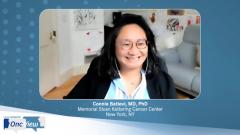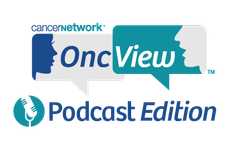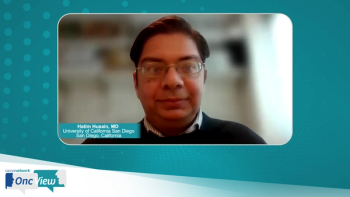
Current Treatment Options and Considerations for Relapsed/Refractory Follicular Lymphoma
Connie Batlevi, MD, PhD, discusses the rate of patient relapse and current treatment options and considerations for relapsed/refractory follicular lymphoma.
Episodes in this series
Kristie L. Kahl: Hi, and welcome to this CancerNetwork® OncView™ program titled “Updates in Therapies of Relapse and Refractory Follicular Lymphoma.” I’m Kristie Kahl, vice president of content with CancerNetwork®. We have with us today Dr Connie Batlevi from Memorial Sloan Kettering Cancer Center in New York, New York. Thank you for joining us today and let’s get started. Dr Batlevi, how many patients relapse after frontline therapy?
Connie Batlevi, MD, PhD: First off, thank you for having me. Follicular lymphoma is considered a noncurable indolent lymphoma. The goals of any treatment are to balance the effectiveness of treatment, as well as the quality of life and cost of care during a treatment decision. In some of our longitudinal studies, about 50% of patients relapse after frontline therapy over a decade of observation. However, as patients are thankfully living beyond a decade, we know that patients are ultimately always at risk for a relapse.
Kristie L. Kahl: What are the treatment goals in the relapsed/refractory setting?
Connie Batlevi, MD, PhD: The selection of treatment at first relapse is dependent on multiple parameters, such as a patient’s functional status, the characteristics of their relapse, their prior treatments, their prior response, and their duration of response to treatment. There are a lot of different treatments. They can be chemotherapy with a CD20-directed antibody, CD20 antibodies by themselves, lenalidomide-based treatments, or even local therapy with radiation.
Kristie L. Kahl: What has been the impact of new treatment options on the overall treatment landscape?
Connie Batlevi, MD, PhD: New treatments in follicular lymphoma are an exciting component of drug development in the space. Over the last several decades, we see that the overall survival and progression-free survival are improving over time with follicular lymphoma. I can only assume that this is partially a result of the many treatment options that we have developed for this lymphoma subtype.
Kristie L. Kahl: What factors do you consider when choosing treatment for first relapse in a relapsed/refractory follicular lymphoma patient?
Connie Batlevi, MD, PhD: There’s a variety of parameters to help us guide treatment selection at the first relapse. First a patient’s functional status, which is independent of their disease status, guides what one may offer. In the clinic, I may be looking at how a patient walks into a room, or I ask about their level of independence at home. Next I evaluate the characteristics of their relapse, the volume of their disease based on imaging, the impact on blood counts based on blood work, metabolic activity as determined by a PET [positron emission tomography] scan, and genetic and pathologic features of their disease, like a high Ki-67 or certain genetic features. A biopsy is almost always an important aspect of disease assessment because these are key to identifying a transformation. A transformation is where the follicular lymphoma changes to diffuse large B-cell lymphoma. If a transformation were to occur, that would change the management. Then I weigh their prior treatments and their response to treatment in order to guide that first relapse treatment.
Kristie L. Kahl: For each treatment option, is there a preferred patient type for each one?
Connie Batlevi, MD, PhD: In many ways patients are able to receive a lot of different types of treatments, but it’s based on all of those other things that we talked about. Broadly speaking, if we gave CHOP-based chemotherapy [cyclophosphamide, hydroxydaunorubicin, vincristine sulfate, and prednisone] for somebody in the frontline setting, we probably would not give CHOP-based therapy again in this first relapse. Similarly, if they got bendamustine in the first round, then they may not get it in the second round. We must balance out the adverse effects of each of those chemotherapy regimens, as well as the duration of those chemotherapy regimens, in order to select it. There’s always immune-based target therapies, like lenalidomide, but those are often longer durations of treatments, and we have to factor in each individual patient’s lifestyle as well. For the truly frail patients, we can make those guides very broad aspects where maybe they should get a single agent anti-CD20 antibody, or localized therapy, or tazemetostat, which is approved to serve in this setting.
Another segue into this is, how do we time that treatment? Just because a patient relapses doesn’t always mean that they require treatment. In the frontline setting, we use criteria like Guelph criteria. This is a set of clinical criteria that was validated to guide frontline treatment of follicular lymphoma. Those criteria include having more than 3 lymph nodes that are more than 3 cm, any 1 lymph node more than 7 cm, or if there’s any effect of the lymph nodes on any critical organs, or impact on blood counts, etc. Although I use those parameters for subsequent lines of therapy, it’s a guide and less so a mandate. I keep it in consideration when deciding which patients in this relapse setting need observation or treatment.
Transcript edited for clarity.
Newsletter
Stay up to date on recent advances in the multidisciplinary approach to cancer.





















































































